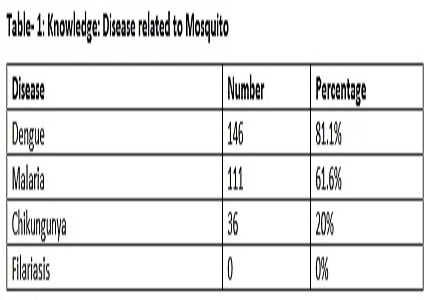Knowledge regarding mosquito borne diseases & control measures practiced among a rural population in a southern district of Tamil Nadu, South India
Abstract
Introduction: Vector-borne diseases account for over 17% of all infectious diseases. Up to 700 million people are infected and more than a million die each year from mosquito-borne illness. The extent of people’s cooperation can determine the success or failure of the entire campaign for Mosquito control.
Methods: A cross-sectional observational study was carried out in Kanyakumari district among 180 individuals selected through multi-stage sampling. Data was collected using a semi structured interview schedule.
Results: Every one of the study participants knew that mosquitoes spread diseases. Dengue was the most common disease related to Mosquito. Among the respondents, 113(62.7%) answered that coconut shells most common mosquito breeding place. Coconut shells (66%) & Open drainages (61.1%) were reason for water stagnation inside & outside their own compound respectively. 71.1% have seen mosquito larva in stagnant water around their house and among them 75.8% have done something to kill larva. Most common method used was putting bleaching powder in the larva breeding places (39%) followed by source reduction (26.5%). Bleaching powder was also the most common method (57%) used for prevention of mosquito breeding. 78.9% of the households were using personal protective measures, mosquito coil (59.8%), the most commonly used method. Only 38.5% of them said that fogging was done in their area in past 6 months.
Conclusion: A good proportion of the households are taking preventive measures, but still so many households lacks practice or found to be doing wrong practices. Therefore, we recommend that community should be empowered with the right & adequate knowledge.
Downloads
References
2. World Health Organization. A global brief on vector-borne diseases. Geneva: World Health Organization; 2014. 54p.
3. World Health Organization. Vector-borne diseases [Internet]. 2016 Feb [cited 2017 Nov 21] Available from: http://www.who.int/mediacentre/factsheets/fs387/en/
4. Caraballo H, King K. Emergency department management of mosquito-borne illness: malaria, dengue, and West Nile virus. Emerg Med Pract. 2014 May;16(5):1-23; quiz 23-4.
5. Gupta I, Chowdhury S. Economic burden of malaria in India: The need for effective spending. WHO South-East Asia Journal of Public Health. 2014 January-March; 3(1): p. 95-102. DOI: 10.4103/2224-3151.115828.
6. Directorate of National Vector Borne Diseases Control Program (NVBDCP). Operational Manual for Integrated Vector Management in India. Operational Manual. Delhi: Ministry of Health & Family Welfare, Directorate General of Health Services; 2016. 98p.
7. Dhaduk KM, Gandha KM, Vadera BN, Mehta JP, Parmar V, Yadav SB. A Community level KAP study on mosquito control in Jamnagar district. National Journal of Community Medicine. 2013 Apr – June; 4(2): p. 321-328.
8. Vala M, Patel U, Joshi N, Zalavadiya D, Bhola C, Viramgami A. Knowledge and Practices regarding commonly occurring mosquito borne diseases among people of urban and rural areas of Rajkot District, Gujarat. Journal of Research in Medical and Dental Science. 2013 October – December; 1(2): p. 46-51.
9. Ashok Kumar V, Rajendran R, Manavalan R, Tewari SC, Arunachalam N, Ayanar K, Krishnamoorthi R, Tyagi BK. Studies on community knowledge and behavior following a dengue epidemic in Chennai city, Tamil Nadu, India. Trop Biomed. 2010 Aug;27(2):330-6. [PubMed]
10. Liu X, Wan F, Cirendunzhu, Cirenwangla, Bai L, Pengcuociren, et al. Community knowledge and experience of mosquitoes and personal prevention and control practices in Lhasa, Tibet. Int J Environ Res Public Health. 2014 Sep 23;11(9):9919–37.
11. Devi SR, Dass S. Environmental factors of malaria persistence: a study at Valiyathura, Thiruvananthapuram city. Thiruvananthapuram: Kerala Research Programme on Local Level Development, Centre for Development Studies; 1999. 26 p. (Discussion paper).

Copyright (c) 2017 Author (s). Published by Siddharth Health Research and Social Welfare Society

This work is licensed under a Creative Commons Attribution 4.0 International License.


 OAI - Open Archives Initiative
OAI - Open Archives Initiative


